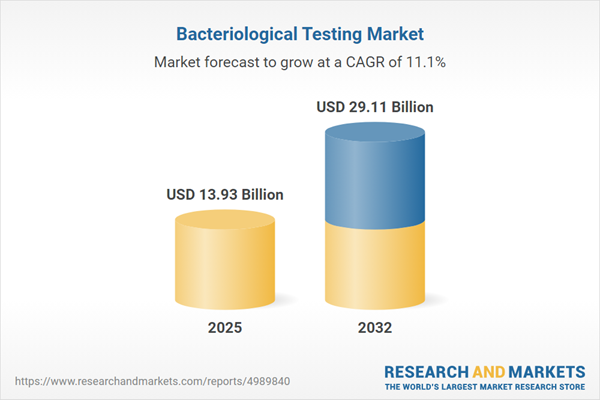Speak directly to the analyst to clarify any post sales queries you may have.
The bacteriological testing market is entering a dynamic phase as demand accelerates across industries prioritizing safety, compliance, and public health. Senior leaders now face strategic decisions in adopting advanced pathogen detection technologies amid evolving regulatory landscapes and operational risks.
Market Snapshot: Bacteriological Testing Market Size and Growth
The global bacteriological testing market grew from USD 12.54 billion in 2024 to USD 13.93 billion in 2025 and is projected to expand at a CAGR of 11.10%, reaching USD 29.11 billion by 2032. This robust growth reflects increased scrutiny for microbial safety in healthcare, food and beverage, environmental management, water treatment, and biopharma manufacturing.
Scope & Segmentation
This comprehensive research report analyzes the bacteriological testing market across key dimensions to deliver actionable insights for stakeholders.
- Applications: Clinical diagnostics, laboratory developed tests, point of care testing, environmental monitoring for air quality and soil sampling, food and beverage safety, pharmaceutical and biotech final products and raw materials, and water testing including both drinking water and wastewater.
- Technologies: Culture testing (automated systems and selective media), immunoassays such as enzyme linked immunosorbent assay and lateral flow assay, next generation sequencing (targeted and whole genome sequencing), polymerase chain reaction (digital PCR and real time PCR), and rapid detection (immunoassay and molecular formats).
- End Users: Environmental agencies, food processing facilities, hospitals and diagnostic labs, pharmaceutical manufacturers, and water treatment plants.
- Sample Types: Blood, food, surface swabs, urine, and water specimens.
- Organism Types: Bacteria, fungi, parasites, and viruses.
- Regions: Americas (including North America and Latin America), Europe, Middle East & Africa, and Asia-Pacific—each with detailed country-level coverage.
- Leading Companies: Thermo Fisher Scientific, Danaher Corporation, bioMérieux SA, F. Hoffmann-La Roche AG, Abbott Laboratories, Siemens Healthineers AG, QIAGEN, Becton, Dickinson and Company, Bio-Rad Laboratories, and Merck KGaA.
Bacteriological Testing Market: Key Takeaways for Decision-Makers
- Rising regulatory demands are prompting end users to accelerate implementation of digital and automated bacteriological testing solutions, especially in regions with strong compliance oversight.
- Cross-sector adoption is intensifying, with stakeholders in healthcare, environmental, food safety, and water utilities increasingly converging around standardized testing platforms to enhance operational resilience and quality control.
- Emerging technologies such as molecular detection, next generation sequencing, and real-time PCR are reshaping sensitivity benchmarks, enabling faster turnaround and broader pathogen coverage.
- Strategic collaborations and M&A activity among diagnostics, reagent, and instrument providers are expanding capabilities while supporting global market access and supply chain adaptation.
- Regional supply diversification and alliances are increasingly critical, especially in dynamic markets such as Asia-Pacific and amid evolving trade policies impacting procurement and distribution models.
Impact of United States Tariffs on Supply Chains
Recently imposed US import tariffs have created substantial headwinds for bacteriological testing equipment supply chains. Manufacturers have responded by investing in domestic production, renegotiating contracts, and exploring alternative sourcing. Diagnostic labs are adapting by seeking refurbished or locally fabricated equipment. Smaller providers may encounter budgetary constraints and must pursue innovative procurement or collaboration strategies to mitigate cost increases.
Comprehensive Research Methodology & Data Sources
This bacteriological testing market report is built on rigorous primary research, including interviews with laboratory directors, regulatory experts, procurement managers, and technology developers. Extensive secondary analysis incorporates journals, patent filings, white papers, and government disclosures. Quantitative modeling and triangulation validate segmentation accuracy, while scenario analysis evaluates the impact of policy shifts on supply chains and pricing.
Why This Report Matters
- Enable boardroom-level strategic planning with intelligence on the future direction of bacteriological testing technologies and regulatory expectations.
- Empower procurement and supply chain leaders to assess and adjust sourcing models in light of policy-driven challenges and competitive activity.
- Support operational decision-makers seeking to future-proof investments by aligning with high-growth regional markets and evolving industry standards.
Conclusion
The bacteriological testing ecosystem is evolving rapidly as innovation, collaboration, and supply resiliency redefine strategic options. This report equips senior stakeholders with vital intelligence to drive informed decisions in safeguarding public health and optimizing operational outcomes.
Additional Product Information:
- Purchase of this report includes 1 year online access with quarterly updates.
- This report can be updated on request. Please contact our Customer Experience team using the Ask a Question widget on our website.
Table of Contents
3. Executive Summary
4. Market Overview
7. Cumulative Impact of Artificial Intelligence 2025
Companies Mentioned
The companies profiled in this Bacteriological Testing market report include:- Thermo Fisher Scientific, Inc.
- Danaher Corporation
- bioMérieux SA
- F. Hoffmann-La Roche AG
- Abbott Laboratories
- Siemens Healthineers AG
- QIAGEN N.V.
- Becton, Dickinson and Company
- Bio-Rad Laboratories, Inc.
- Merck KGaA
Table Information
| Report Attribute | Details |
|---|---|
| No. of Pages | 189 |
| Published | October 2025 |
| Forecast Period | 2025 - 2032 |
| Estimated Market Value ( USD | $ 13.93 Billion |
| Forecasted Market Value ( USD | $ 29.11 Billion |
| Compound Annual Growth Rate | 11.1% |
| Regions Covered | Global |
| No. of Companies Mentioned | 11 |









